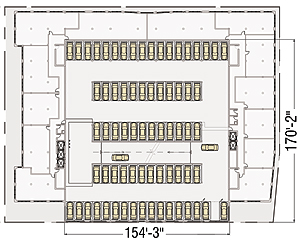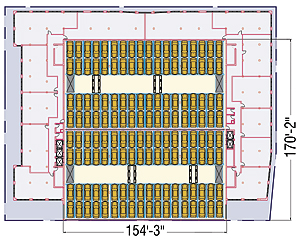|
Automated Parking Garage Solutions Hold Key To Urban Development
Today's leading urban planners and downtown developers are rethinking their allegiance to single-use zoning practices and focusing on building communities in order to create neighborhoods in which people can live, socialize, shop, and perhaps even work - all within a comfortable walking distance. While large suburban yards were recently the sought-after American ideal, today, high gas and petrol prices make living close to friends, neighbors, social activities, and public transportation more attractive than suburban scrawl. High-density living naturally reduces household gasoline usage without crimping personal freedom or creating feelings of undue sacrifice. The Congress for the New Urbanism (CNU) is a multidisciplinary organization in which urban planners, real estate developers, architects, builders, suppliers and others work together to solve land use problems with a heavy emphasis toward mixed use developments. CNU President and CEO John Norquist states that high-rise cities like Philadelphia and New York rarely come to mind as models of environmentalism, but they should. He backs this up by citing a report prepared for New York Mayor Michael Bloomberg's green blueprint, PlaNYC, showing that New Yorkers generate, on average, 7.1 metric tons of greenhouse gases a year, two-thirds less than the average 24.5 metric tons generated by most Americans. The green building movement is also growing in popularity among many urban builders and developers. For a building to qualify as green, it must meet certain standards for design, construction, and operation such as those set forth by the nationally accepted Leadership in Energy and Environmental Design (LEED) Green Building Rating System. Some of the things that help qualify a building as "green" in the US, Europe, the Middle-East and Asia are the use of natural light, energy-efficiency, water savings, building materials, and indoor environmental quality. Renovation projects are also subject to reuse of a certain percentage of the original construction material, helping the environment by creating less waste than a traditional "tear down and build" project. While many cities and towns from New York, Chicago and Hoboken to London, Paris and Tel Aviv are moving forward with multi-use buildings and redevelopment of their downtowns, some projects are being held up because of the need for parking space. Local parking regulations require building developers to provide a certain number of parking spaces per "X" square feet of office, commercial or residential space, as even environmentally conscious residents of high-density communities want to be able to access their cars on the weekends and other key times. In areas such as Los Angeles, the adaptive reuse movement to renovate blighted historic buildings virtually ground to a halt because of lack of parking. Architect Wade Killefer, founding partner of Killefer Flammang Architects, says that lack of parking is keeping some 140 sites in Los Angeles from being converted into housing, parks and other space. Automated parking garages are one the creative solutions being proposed to address these problems. Automated parking garages utilize computer-controlled motorized vehicles such as lifts, conveyors and shuttles to transport passenger cars from the arrival level to a parking space and vice versa, without human assistance. Customers simply drive into a friendly entry bay and stop, exit and lock their car. Upon return, the automated parking garage system retrieves the car and quickly delivers it to the driver in a convenient exit-facing position.
Conventional parking (l.) in contrast to cost, time and space effective automated parking (r.)
Automated
parking garages have captured the attention of building and
real estate developers, architects, builders and municipalities,
not because of their cool, futuristic robotics features, but
because of their space-saving efficiencies. Automated parking
garages can hold two to three times the number of cars as traditional
ramp-style parking garages of the same volume. This enables
building developers in the US, Europe, South America, Middle-East
and Asia to meet their parking requirements in less space and
thus be able to profit from more housing, office and or commercial
units than they would have with a traditional ramp-access garage. Urban planners and architects in the US, England, Canada, Spain, France, Germany, Italy, Sweden, Israel, Saudi Arabia, Russia, Japan, China and dozens of other nations also like the idea because it gives them more design flexibility and enables facades to match the architects vision, and not stand out as neighborhood eyesores. The idea of automated parking garage solutions has also caught on among green building movements because cars and vans are parked with their engines off, significantly reducing exhaust emissions and the problem of carbon monoxide and other pollutants creeping into the surrounding office, residential and retail space. ”The amount of land consumed by conventional parking garages in proportion to the habitable space of the buildings they serve is enormous,” says architect and CNU member, Neal Payton, of Torti Gallas and Partners. “For that reason, we have a number of clients planning major urban projects utilizing robotic parking, primarily to save land and to make the projects financially feasible.” Having exhibited at the International Parking Institute's annual conference and expo held in Tampa, Florida in May, Rafi Stoffman, VP Sales and Marketing for Unitronics, a leading provider of automated parking solutions in the U.S., reports, "Parking is a growing problem in almost every city in the US and around the world. The search for parking places a burden on city streets and adversely affects the environment and quality of life," says Stoffman. The Unitronics automated parking garage solutions executive adds: "The good news is that the real estate, building and parking industries are working together to help alleviate this problem. The high number of visitors to our booth and interest in our new generation Automated Parking Solutions are proof that the North American market is taking off, and we're excited to play a key role in this movement." Automated parking provides customers with a valet-parking like experience that is fast, safe and in many cases, less expensive or equal to regular parking solutions. The automated car retrieval process can take between one to three minutes depending on the size of the system and the location of the car. Additional advantages include the fact that customers no longer have to waste time driving around looking for a parking space or trying to remember where they parked their car upon return. They also benefit from reduced risks of damage and theft and increased personal security since the actual parking area is not accessible to the public. Creative parking solutions can go a long way towards making our world a cleaner and nicer place to live.
Related Websites:
Sponsored by IsraelPr.com |


